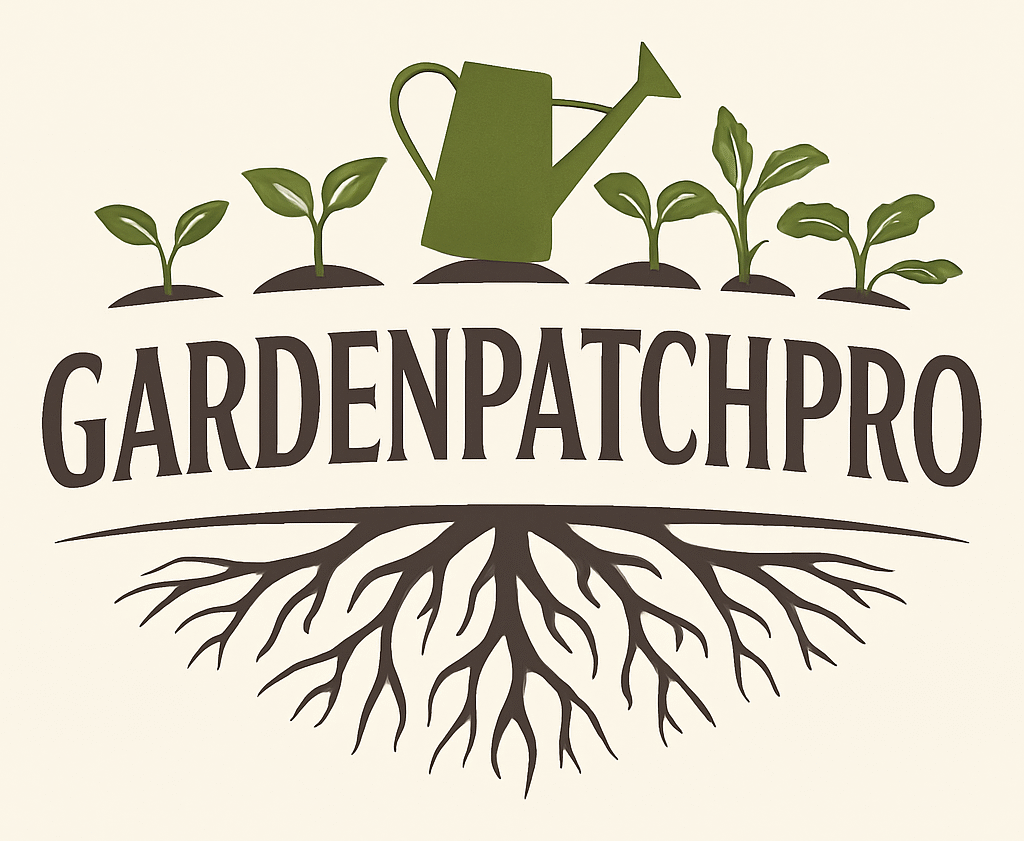10 Gothic Garden Ideas To Transform Your Outdoor Space With Dark Elegance
A gothic garden offers a unique way to create an outdoor space that blends dark elegance with natural beauty. It focuses on moody colors, dramatic plants, and vintage-inspired decor to build a mysterious atmosphere.

This style appeals to those who want a garden that feels both enchanting and different from traditional bright, sunny designs. Gothic gardens can bring a sense of calm and intrigue, making them a striking choice for any backyard.
1) Black wrought iron gates to frame garden entrances

Black wrought iron gates create a strong, classic look for garden entrances. Their dark color fits well with gothic design, adding a sense of mystery and structure to the space.
These gates are often made with detailed patterns like arches, spikes, or scrolls. This craftsmanship makes them both functional and decorative.
Wrought iron gates provide security while still allowing visibility, so the garden remains inviting but protected. They can be paired with stone walls or ivy-covered fences for a complete gothic feel.
Choosing gates with a powder-coated finish helps them resist weather damage and rust. This means they stay attractive with minimal maintenance over time.
Using black wrought iron gates is a simple way to frame a garden entrance and set the tone for a gothic outdoor retreat. You can explore styles and ideas at sites like this page on black wrought iron gates.
2) Weathered stone statues for a vintage gothic feel
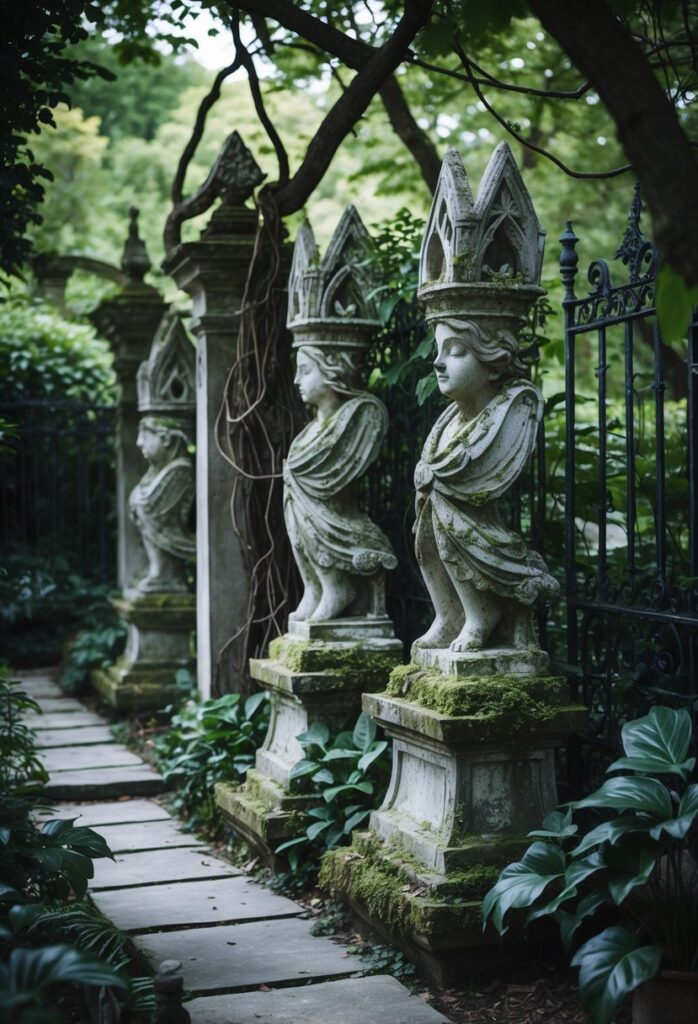
Weathered stone statues add a timeless and vintage look to a gothic garden. Their worn surfaces and aged appearance create an authentic sense of history. This helps bring out the moody and mysterious vibe that defines gothic spaces.
Such statues often feature classic gothic themes like gargoyles, angels, or mythical creatures. Placing them in key spots, like near pathways or flower beds, draws the eye and sets the tone.
Materials like aged stone or cast iron work well because they withstand weather while keeping a traditional look. These statues can also act as focal points, balancing the plants and other decorations in the garden.
Using weathered stone statues combines art and nature. They add structure without overpowering the darker colors and designs typical in gothic gardens.
For ideas and examples of these statues, check out this collection of gothic stone statue options.
3) Deep purple and black flowers like Black Velvet petunias

Black Velvet petunias are popular in gothic gardens because of their deep, almost black petals. They have a velvety texture that gives them a unique and dramatic look. These flowers bloom from late spring until autumn, adding long-lasting color to the garden.
They thrive best in zones 9 to 11 and prefer full sun with well-drained soil. Their dark petals contrast well with lighter greens, making them stand out in any garden.
Other deep purple and black flowers can also create a similar moody effect. Combining these colors adds depth and a mysterious atmosphere to the space. For more ideas on using these flowers, see this guide on black velvet petunia plants for your gothic garden vibe.
4) Ivy-covered walls for a mysterious backdrop
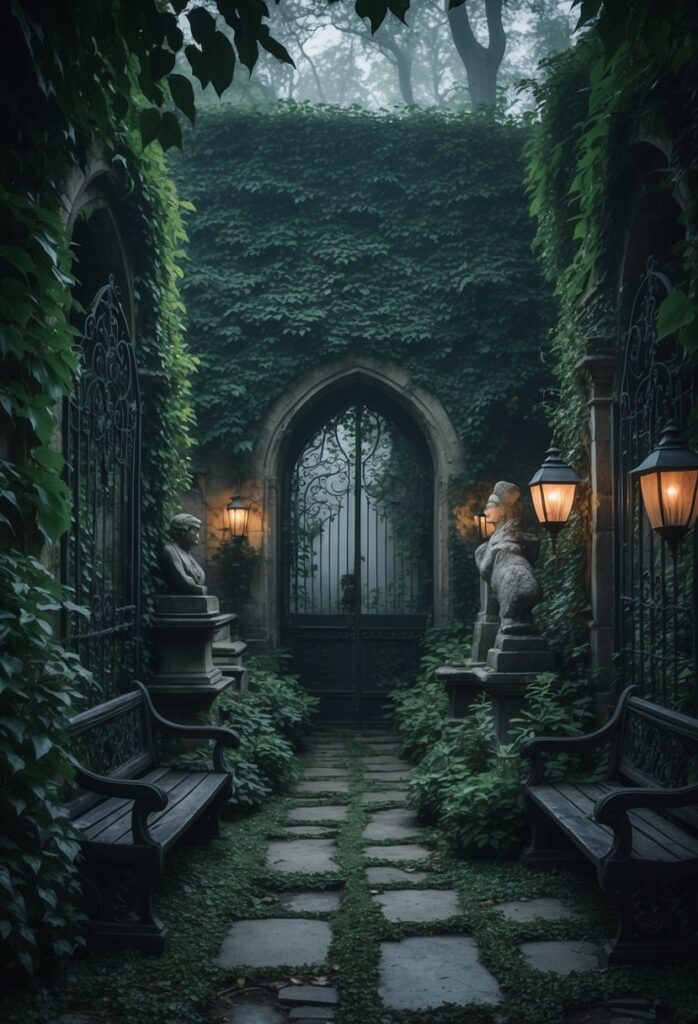
Ivy-covered walls add a natural, mysterious look to any gothic garden. The thick green leaves growing over stone or brick create a sense of age and secrecy. This look can make the garden feel like a hidden space from another time.
Using English ivy or Virginia creeper works well for climbing and covering walls. These plants grow densely, giving the garden an overgrown, enchanted feeling. The dark green foliage contrasts nicely with gothic decorations like iron gates or stone statues.
Ivy also helps soften hard surfaces and adds texture to the garden walls. It can climb fences, stone, or wooden walls, turning these areas into a quiet, shaded retreat. This makes the garden more inviting but still keeps its dark, gothic vibe.
For inspiration, many gothic garden ideas include ivy-covered walls to create a haunting yet beautiful atmosphere. This feature works year-round, making it a strong choice for those wanting a timeless, mysterious outdoor space. Learn more about using ivy in gothic gardens at 18 Gothic Garden Ideas That Will Haunt You with Beauty.
5) Lantern-lit paths with vintage-style candle lanterns
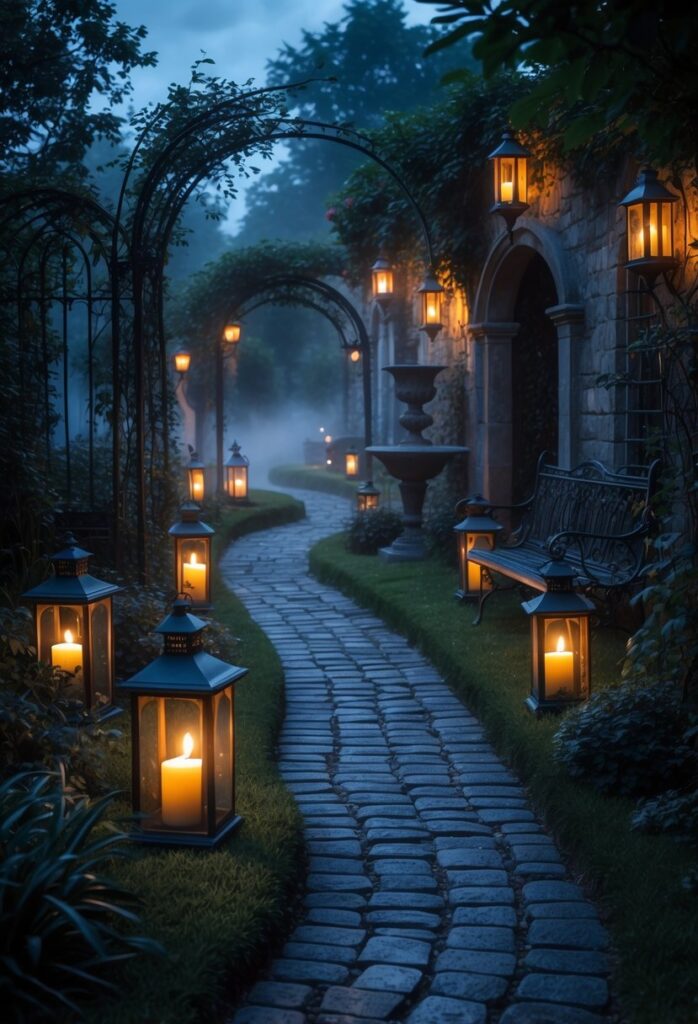
Lantern-lit paths add a soft, warm glow to a gothic garden. Vintage-style candle lanterns fit well with this theme because they offer a timeless, classic look. Their flickering light creates an inviting atmosphere without being too bright.
These lanterns can be placed along walkways or hung from hooks to guide visitors. Choosing lanterns with intricate metalwork or dark finishes strengthens the gothic vibe. Candlelight inside offers a natural, gentle illumination that blends nicely with moody garden settings.
Solar-powered or battery-operated candles are good options for ease and safety. They avoid open flames while still keeping the look of real candles. This helps maintain the garden’s dark, mysterious feel without extra risk.
A path lined with vintage-style lanterns encourages slow walks and quiet reflection. It complements other gothic elements like black iron gates and ivy-covered walls. For more ideas, see lantern lighting in garden paths.
6) Dark-colored gravel or slate for pathways
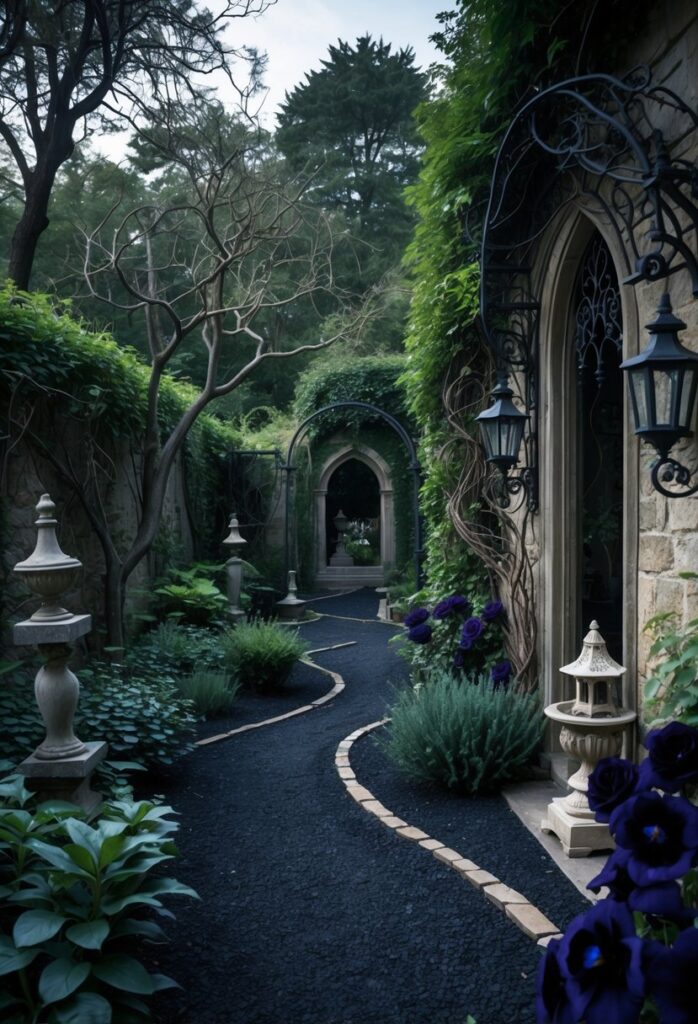
Dark-colored gravel or slate can add a strong visual impact to a gothic garden. These materials create a sharp contrast with green plants and bright flowers, making the pathways stand out clearly.
Using charcoal gravel or slate stones helps set a moody, somber tone. They also reflect less light, which fits well with the Gothic style’s mysterious feel.
These paths can be designed in winding or straight patterns depending on the garden’s layout. Adding stepping stones with organic shapes breaks up the space and guides visitors softly through the area.
Dark pathways pair well with other gothic features like wrought-iron gates or stone arches. They help create a unified look that feels both elegant and eerie.
For ideas and tips on using dark gravel or slate, one can refer to 15 Gravel Walkway Ideas to Welcome Guests Into Your Garden or explore 35 Gorgeous Ideas for a Goth Garden.
7) Victorian-inspired garden benches and furniture
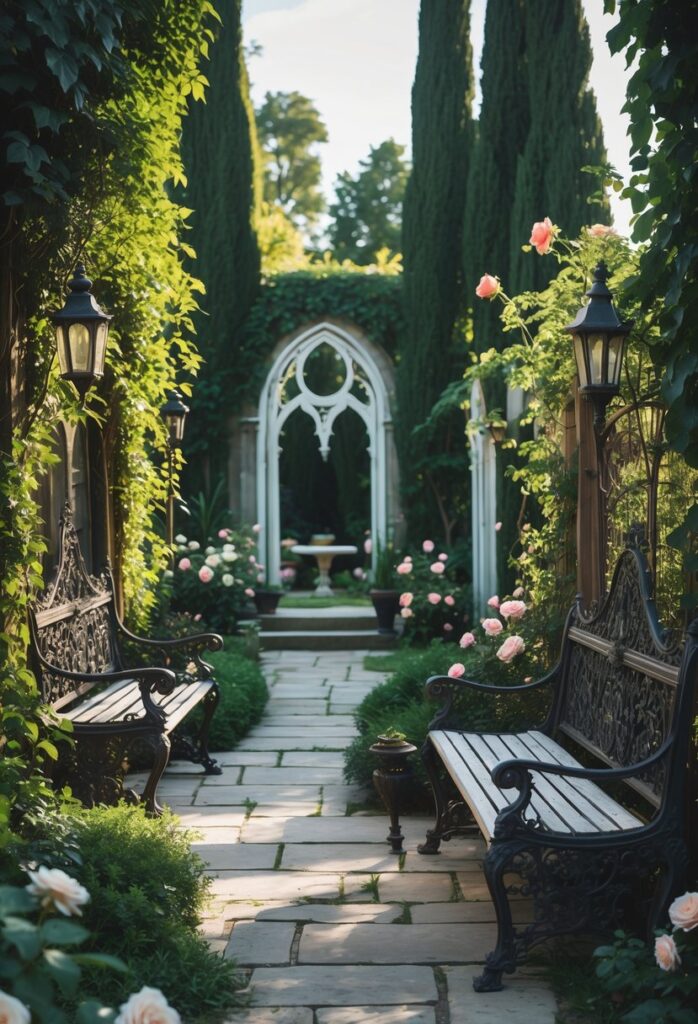
Victorian-style benches and furniture add a strong gothic touch to any garden. These pieces often feature intricate wrought iron designs with detailed filigree work. They create an elegant and dark atmosphere that fits well with gothic garden themes.
Painting garden furniture in matte black enhances its mysterious look. Adding cushions with velvet or lace materials can bring a soft, romantic feel. This contrast helps balance the dark metal with comfort and style.
Wooden benches painted in deep colors like black or dark green also work well. They provide a classic, timeless look that matches gothic elements such as ivy or lantern-lit paths. Combining Victorian details with gothic colors brings a unique charm to outdoor spaces.
Choosing the right garden furniture is key for creating a gothic garden. Wrought iron or vintage Victorian pieces not only look beautiful but also last long outdoors. This makes them a practical choice for gothic garden design.
For more ideas on Victorian-inspired garden furniture, see gothic garden ideas with Victorian details.
8) Moody lighting with solar garden lights and spotlights
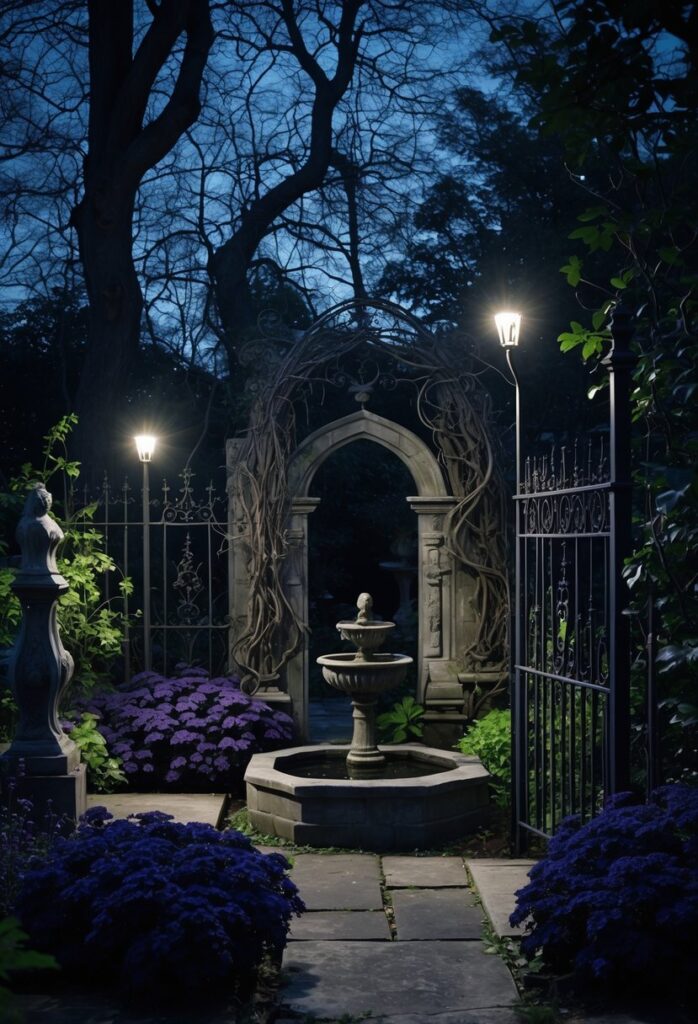
Moody lighting is key to creating a gothic garden atmosphere. Solar garden lights provide a soft, eco-friendly glow that enhances shadows and adds mystery. They are easy to install and use no wiring, making them practical for any outdoor space.
Spotlights can highlight statues, dark foliage, or architectural features. Placing them at ground level or hidden spots creates dramatic contrasts. This lighting style draws attention to specific areas while leaving others dim, adding depth and intrigue.
Using a mix of solar lights and spotlights allows for flexible design. They can be adjusted to shine on carved stone, wrought iron fences, or twisted trees. This layering of light and shadow is important to achieve a gothic look without harsh brightness.
For a gothic garden, warm or cool white lights work well. Avoid colorful bulbs to keep the mood subtle. Many learn how to use solar lights effectively from ideas on garden solar lighting and outdoor solar light designs.
9) Black metal garden arches with climbing roses
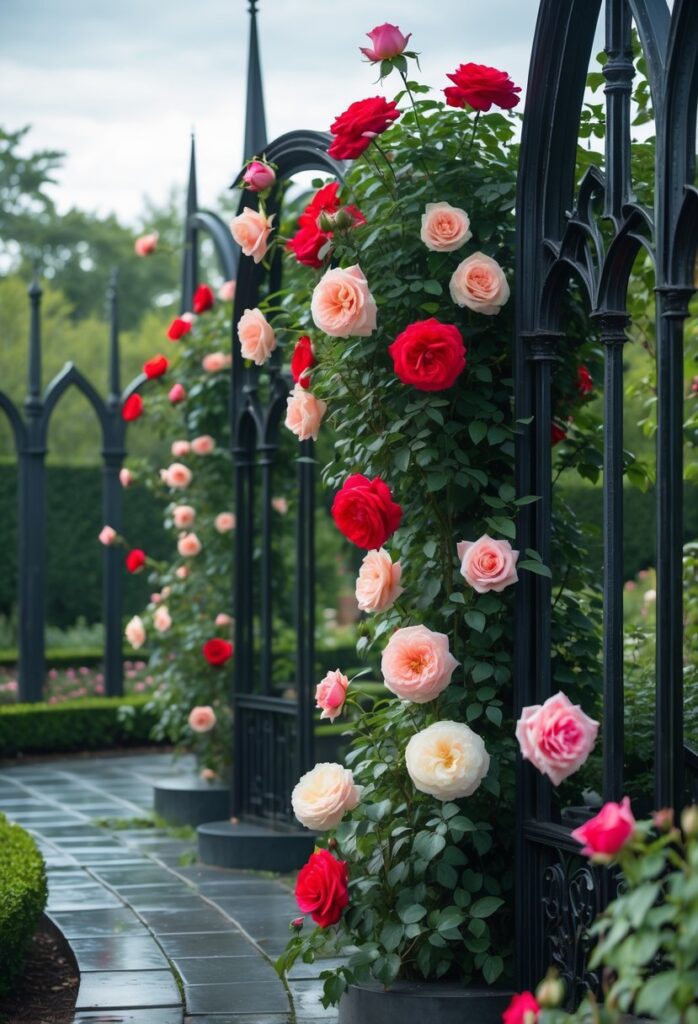
Black metal garden arches create a strong and elegant frame in any Gothic garden. Their dark color adds a sense of mystery and fits well with the Gothic theme.
Climbing roses on these arches bring softness and color. Deep red or purple roses offer a rich contrast to the black metal. They add beauty while maintaining the garden’s dark, dramatic look.
The metal used in these arches is often weather-resistant, making them durable outdoors. They can support heavy climbing plants through the growing season.
These arches work well as garden entrances or pathway features. Decorating them with fairy lights can enhance the Gothic atmosphere even more.
Using black metal arches with climbing roses helps make a garden feel both bold and enchanting. This mix of metal and plants balances strength and nature in a Gothic setting.
More ideas on black metal garden arches with climbing plants can be found at Agriframes USA or Pinterest for inspiration. For a darker look with climbing roses, see this black metal garden arch idea page.
10) Skull or gargoyle garden sculptures
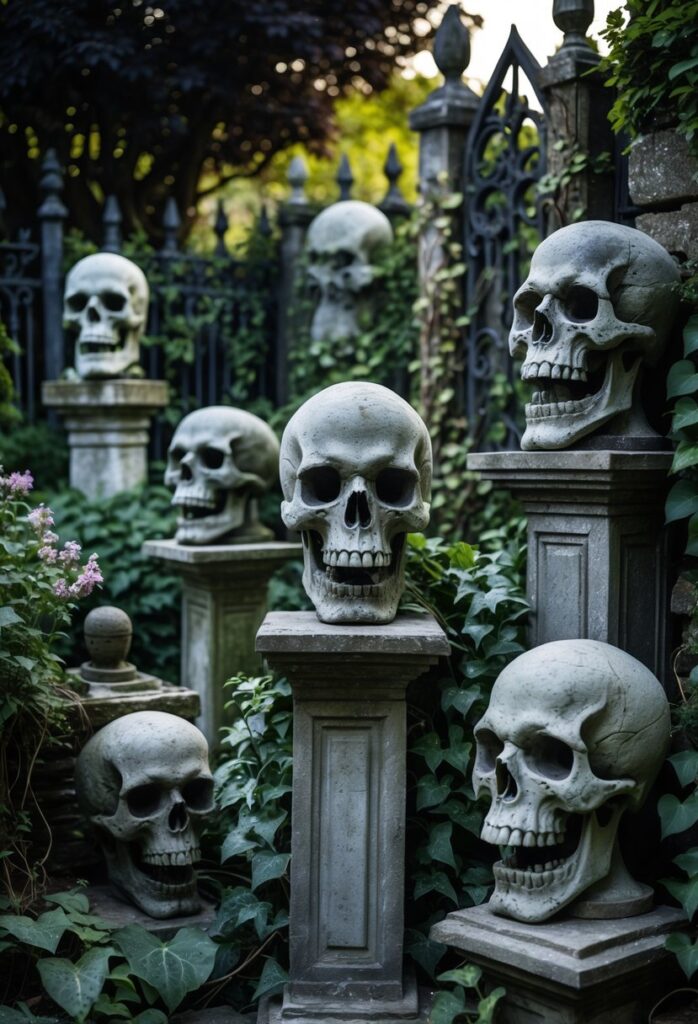
Skull and gargoyle sculptures add a strong gothic touch to any garden. They create a sense of mystery and history that fits well with darker garden themes. These sculptures often serve as eye-catching focal points.
Gargoyles are known for their fierce expressions and detailed designs. Placing them among dark-leaved plants or near stone pathways enhances the gothic feel. They also give a sense of ancient protection to the garden.
Skull sculptures add a macabre but artistic element. They can be used in pathways or tucked into corners with moody flowers and vines. Both skulls and gargoyles bring an eerie timelessness that many gothic gardens aim for.
For ideas on how to use these sculptures effectively, seeing different designs can help. Examples include stone gargoyles placed near plant clusters or skull motifs incorporated into stone paths. These ideas enhance the dark, enchanting look of a gothic garden. More about using gargoyles in garden design can be found at this gothic garden ideas page.
Essential Elements for a Gothic Garden

A gothic garden combines specific plants, architectural details, and color choices to create a dark, moody outdoor space. Each of these parts plays a role in setting the right tone and atmosphere.
Classic Plant Choices
Plants in a gothic garden often include dark or unusual varieties. Black or deep purple flowers like black tulips, dark dahlias, and purple irises are common. Evergreens such as yew bushes keep the garden feeling dense and mysterious year-round.
Ivy and moss add a wild, aged look when they climb walls or cover stone features. Thorny plants like black roses or barberry bushes contribute to the dramatic feel. Ferns or hostas in shaded areas add texture without bright colors.
Choosing plants that can grow well in low light or cooler climates is important. This makes it easier to keep the dark, moody vibe without struggling to maintain the garden.
Architectural Features
Strong architectural elements are key in a gothic garden. Black wrought iron gates, fences, and arches create structure and lend a timeless quality. Stone statues or gargoyles add old-world charm and a touch of eeriness.
Thick stone walls, weathered steps, and rustic wooden gates help define the space and give it a sense of history. Lanterns and candle holders in wrought iron or black metal add soft, warm light at night.
These features should feel sturdy and aged, not new or polished. Using natural materials like stone and iron supports the gothic style’s connection to the past.
Color Palettes and Accents
A gothic garden uses dark and muted colors. Black, deep red, purple, and green dominate the palette. Flowers and foliage reflect these tones to keep the mood consistent.
Accents such as black planters, dark wood furniture, and metal details in bronze or black complement the plants. Lighting is also important. Soft, warm lights in lanterns or candles enhance the gothic feel without brightening the space too much.
Avoid bright or pastel colors. Instead, focus on rich, deep hues that blend with shadows and create a sense of mystery. This careful color mix shapes the garden’s unique atmosphere.
For more ideas on gothic garden design, see 10 Gothic Garden Ideas to Create a Dark, Enchanting Outdoor Space.
Design Considerations and Maintenance
A gothic garden requires deliberate care to maintain its unique atmosphere and visual appeal. Proper timing for plant care and the right lighting can enhance the garden’s mood and ensure the features stay sharp and inviting.
Seasonal Care Tips
Plants common in gothic gardens, like dark-hued flowers and ivy, need seasonal attention to keep their lush, moody look. In spring, pruning dead branches and removing old leaves help prevent disease and encourage fresh growth.
During summer, regular watering is crucial, especially for moisture-loving plants like ferns. Mulching protects roots and keeps the soil cool. Watch for pests that target both flowers and stone features.
In fall, clean fallen leaves promptly to avoid mold and decay that can harm plants. Prepare statues and iron elements for winter by covering them or applying rust-resistant sprays.
Winter care means checking that heavy snow doesn’t damage branches or structures. Some plants may need indoor shelter or frost blankets to survive colder months.
Lighting and Ambience
Lighting plays a key role in creating the gothic garden’s shadowy, dramatic effect. Installing low, soft lights along paths highlights statues and wrought iron gates without overpowering the dark theme.
Lanterns with flickering LED candles add warmth but keep the atmosphere mysterious. Spotlights on focal points like Victorian statues should use cool tones for a ghostly glow.
Solar-powered garden lights reduce energy use and are easy to install. Timers and dimmers help balance illumination and darkness, allowing for a moody setting all night.
Avoid bright white bulbs that ruin the mood. Instead, use amber or deep purple filters to enhance colors naturally found in the garden.
Frequently Asked Questions
Key features like wrought iron gates, stone statues, and lantern-lit paths help set the mood. Dark-colored flowers and ivy-covered walls add to the mysterious atmosphere. Garden planters and DIY elements can boost the gothic style with careful choices in materials and arrangements.
What elements are essential for designing a Victorian Gothic garden?
Black wrought iron gates create a strong first impression and frame the space. Weathered stone statues add vintage charm and a historic touch. Ivy-covered walls provide a lush, mysterious backdrop that ties the look together. Lantern-lit paths with vintage-style candle lanterns enhance the atmosphere in the evening.
Which plants are typically used to create a dark and moody atmosphere in a goth garden?
Deep purple and black flowers, like Black Velvet petunias, bring rich, dramatic color. Ivy is often used to cover walls or structures. Other dark-hued plants, such as black calla lilies or purple salvia, also help maintain the shadowy tone.
How can you incorporate gothic decor into an outdoor garden space?
Decorate with Victorian-inspired statues and wrought iron furniture. Use black or dark-colored planters and decor pieces. Adding vintage-style lanterns and candle holders along paths or seating areas enhances the gothic feel. Weathered stone or metal can be used for an aged effect.
What DIY projects can enhance the gothic aesthetic of a garden?
Painting old planters black or deep purple can freshen their look. Crafting lantern holders or candle fixtures from wrought iron or dark wood adds character. Building archways covered in ivy or climbing plants helps create secluded, shadowy spots.
How do you select and arrange garden planters to fit a gothic theme?
Choose planters in dark colors or with an aged finish. Arrange them symmetrically around entrances or pathways for a formal look. Mix stone and wrought iron materials to keep the vintage gothic style consistent. Use planters to frame key features like gates or statues.
Can you recommend some flowers that thrive in a garden with a gothic design?
Black Velvet petunias are a top choice for their dark, rich petals. Purple salvia and black calla lilies add variety in shape and height. Ivy is useful as a climbing or ground cover plant. These plants can handle typical garden conditions while fitting the gothic color scheme.
